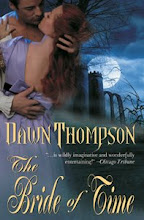
In 2008 I presented a workshop for Romance Writers of America chapter Valley Forge Romance Writers called POWER TITLES. A short article based on the workshop followed and was published in several RWA chapter publications.
Since writers seem to find the POWER TITLES information helpful, I'm posting the article here. Please give proper credit when referencing this article.
POWER TITLES by Adele Dubois
Your book title is a powerful marketing tool. Whether your romance novel sits on a bookstore shelf, is listed on an e-publisher site, or is yet an unpublished manuscript, your title makes a critical first impression on readers and editors. Does your title have that wow factor that hooks your target readership and makes them want to know more? Is your ‘working title’ so powerful your publisher will approve it?
Here are tips on how to write a ‘working title’ that will increase your chances of publisher acceptance when your contract is signed.
• Keep it short. A great title should be read at a glance. Four words are the maximum recommended length, but three words or less is best.
• Encapsulate your genre. Your title should offer a snapshot of your story genre (Romance) and sub-genre (Paranormal, erotic, suspense, comedy, science fiction, fantasy, inspirational, historical, etc.).
• Use compelling key words that evoke vivid mental pictures. A strong visual of your story concept creates the emotional response needed to produce sales.
• Make it original. Use ‘power words’ in combination that are fresh and memorable. Be unique.
• Be cool and current. Avoid old-fashioned expressions, cliché, glib, pretentious or trite language.
• Use active, not passive, phrases. DESERT FEVER is active. “Fever in the Desert” is passive and packs less punch.
Editor Advice:
Raelene Gorlinksy, Publisher, Ellora’s Cave Romantica Publishing, says, “Have a focus word. Make it grab the reader—it should be interesting or intriguing or suggestive.”
Hilary Sares, Editor, Kensington Publishing Corp., says, “Long, Latinate, erudite titles seem to be a particular weakness of newbie historical authors…ditto legal thriller writers. The contemps, anything goes—but authors often get too ‘telly’ or too trite. I wish I had a nickel for every contemp romance I saw that was called Second Chances. If you want your manuscript to be remembered, try to do better than that.”
Rhonda Penders, Editor-In-Chief of The Wild Rose Press, says, “Titles with double meanings are always fun for the erotic reads. Something different, unusual. If you have the same title as a dozen other books it doesn't work. You want to be unique and original without being too strange. Titles, like covers, are big marketing pieces, and sometimes it’s best to let the marketing department help the editor and author choose what would work best for a story… The best advice I can give is to make it catchy, cute if it fits the story, and make it grab the reader.”
© Adele Dubois 2008
**********
Adele Dubois is the author of DESERT FEVER, INTIMATE ART, DREAM TRAVELER, and MOTORCYCLE HEAT-- titles Adele created that were approved by her publishers at Ellora’s Cave and Loose Id. POWER TITLES Workshop available upon request. Visit Adele’s website and blog at
www.adeledubois.com/ 
POWER TITLES by Adele Dubois




















































